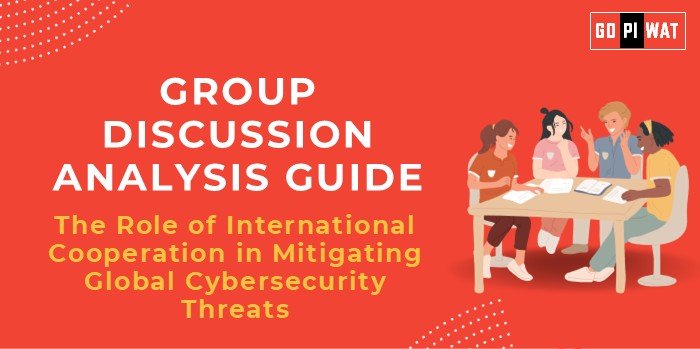📋 Group Discussion Analysis Guide: The Role of International Cooperation in Mitigating Global Cybersecurity Threats
🌐 Introduction to the Topic
📖 Opening Context
“In an increasingly interconnected world, cybersecurity breaches have far-reaching consequences, threatening national security, global economies, and individual privacy.”
📜 Topic Background
International cooperation in cybersecurity aims to harmonize strategies across borders, share intelligence, and establish legal frameworks to combat growing cyber threats. Initiatives like the Budapest Convention and partnerships such as the Global Forum on Cyber Expertise exemplify collaborative efforts.
📊 Quick Facts and Key Statistics
- 💰 Global Cybercrime Costs: Estimated to reach $10.5 trillion annually by 2025, showcasing the economic gravity of the issue.
- 🔐 Data Breaches: Over 22 billion records exposed globally in 2022.
- 🛡️ Ransomware Growth: A 92% increase in ransomware attacks since 2021, highlighting the urgency of global responses.
- 🌍 Budapest Convention Membership: 68 countries, emphasizing the treaty’s widespread adoption.
🤝 Stakeholders and Their Roles
- 🏛️ Governments: Establish frameworks, enforce cybersecurity laws, and participate in treaties like the Budapest Convention.
- 💻 Private Sector: Develop advanced security technologies and share threat intelligence.
- 🌐 International Organizations: UN, NATO, and ITU lead standardization and foster diplomatic cyber relations.
- 📚 Academia and NGOs: Conduct research and advocate for equitable cybersecurity measures globally.
🏆 Achievements and Challenges
✨ Achievements
- 🔧 Creation of CERTs: Established in 140+ countries to respond to cybersecurity incidents.
- 🛡️ Widespread Adoption of GDPR: Influenced global privacy standards.
- 🌍 EU’s NIS Directive: Improved cross-border cyber-resilience within Europe.
⚠️ Challenges
- 📜 Fragmented Legal Frameworks: Differing national priorities hinder global harmonization.
- 🤝 Low Cooperation: Non-signatory countries resist global treaties.
- ⚔️ Geopolitical Tensions: Rising mistrust escalates risks of cyber warfare.
🌍 Global Comparisons
- ✅ Success: Estonia serves as a global model for cybersecurity resilience.
- ⚠️ Challenges: Trust deficits between major powers like China and the US hinder collaboration.
📖 Case Studies
- 📡 2021 SolarWinds Attack: Highlighted the necessity for international threat intelligence sharing.
💡 Structured Arguments for Discussion
- 🛠️ Supporting Stance: “International treaties like the Budapest Convention provide the foundation for cross-border cybersecurity collaboration.”
- 🛡️ Opposing Stance: “Cyber sovereignty concerns hinder trust and full-fledged international cooperation.”
- ⚖️ Balanced Perspective: “While progress exists, greater trust and unified frameworks are essential for impactful results.”
🎯 Effective Discussion Approaches
🔑 Opening Approaches
- 📈 Highlight Economic Cost: “Cybercrime costs are projected to reach $10.5 trillion annually by 2025, underscoring the need for global collaboration.”
- 🌐 Reference Successful Collaborations: “The Budapest Convention exemplifies international cooperation in cybersecurity.”
⚙️ Counter-Argument Handling
- 🔄 Rebuttal: “Address sovereignty concerns by highlighting mutually beneficial outcomes like joint ransomware task forces.”
🧠 Strategic Analysis of Strengths and Weaknesses
SWOT Analysis:
- 💪 Strengths: Growing awareness, technological advancements, and legal frameworks.
- 🛠️ Weaknesses: Geopolitical tensions and resource gaps in developing nations.
- 🌟 Opportunities: Expansion of partnerships and capacity-building in underserved regions.
- ⚠️ Threats: Cyber warfare escalation and technology misuse.
🏫 Connecting with B-School Applications
📚 Real-World Applications
- 🌍 Cybersecurity frameworks in risk management or corporate governance projects.
🎓 Sample Interview Questions
- ❓ “How can international cooperation address the digital divide in cybersecurity?”
- ❓ “Evaluate the impact of treaties like the Budapest Convention.”
💡 Insights for Students
- 📈 Explore cybersecurity as a facet of corporate risk, global economics, and digital transformation.


